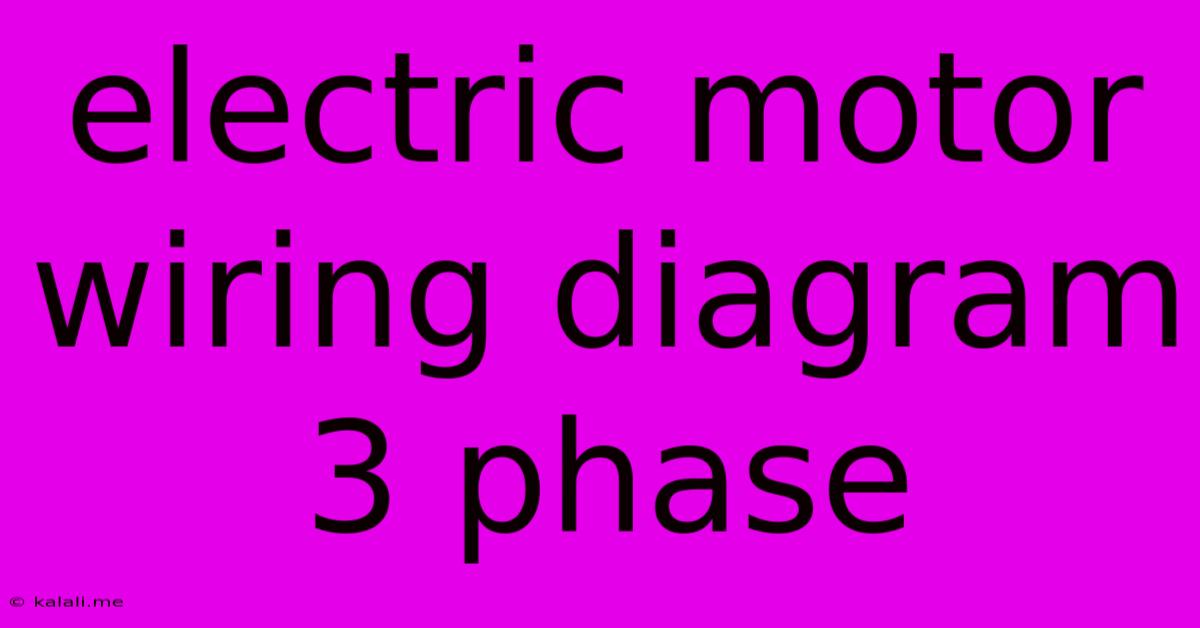Electric Motor Wiring Diagram 3 Phase
Kalali
Jun 01, 2025 · 3 min read

Table of Contents
Decoding the Mystery: A Comprehensive Guide to 3-Phase Electric Motor Wiring Diagrams
Understanding 3-phase electric motor wiring diagrams might seem daunting at first, but with a systematic approach, it becomes manageable. This comprehensive guide will break down the intricacies of these diagrams, helping you confidently connect and troubleshoot your 3-phase motor. This guide covers common configurations, troubleshooting tips, and safety precautions, making you proficient in handling these essential components of industrial machinery and power systems.
What is a 3-Phase Electric Motor?
A 3-phase electric motor is a powerful and efficient type of AC motor utilizing three phases of alternating current to generate a rotating magnetic field. This field interacts with the motor's rotor, causing it to spin. They are widely used in industrial applications due to their high power-to-size ratio and efficiency compared to single-phase motors. Common applications include pumps, compressors, conveyors, and industrial machinery of all kinds. Understanding their wiring is crucial for safe and effective operation.
Understanding the Wiring Diagram:
3-phase motor wiring diagrams use various symbols and conventions to represent the motor's internal windings and external connections. Key elements to look for include:
- Terminals: These are the connection points on the motor itself, usually labeled with letters (e.g., U, V, W, or L1, L2, L3) corresponding to the three phases.
- Windings: The internal coils of wire within the motor that generate the magnetic field. They are connected in specific configurations (star or delta) to achieve the desired motor operation.
- Start and Run Capacitors (for some configurations): These components are used in specific motor designs to aid in starting and running, especially in capacitor-start/capacitor-run motors. These are not always present in all 3-phase motors.
- External Power Supply: The diagram will show the connection points for the three-phase power source.
Common Wiring Configurations:
Two primary configurations exist for connecting the windings of a 3-phase motor:
1. Star (Wye) Connection:
- Diagram: The three windings are connected together at a common point (the neutral point), and the three external leads are connected to the ends of each winding.
- Voltage: The line voltage (voltage between the phases) is √3 times the phase voltage (voltage across each winding).
- Advantages: Lower starting current compared to delta connection, offers better protection against voltage imbalances.
- Disadvantages: Lower starting torque compared to delta connection.
2. Delta Connection:
- Diagram: The three windings are connected in a closed loop, forming a triangle. The three external leads are connected to the junction points of each winding.
- Voltage: The line voltage and phase voltage are equal.
- Advantages: Higher starting torque compared to star connection, simpler wiring.
- Disadvantages: Higher starting current compared to star connection, more susceptible to voltage imbalances.
Interpreting the Diagram:
A typical diagram uses color codes (often brown, black, and gray) or letters to represent each phase. Follow the lines connecting the terminals to the windings to understand the configuration (star or delta). The diagram will also show how the external power supply connects to the motor terminals. Always consult the motor's nameplate for the correct voltage and wiring instructions specific to your motor.
Troubleshooting Common Issues:
- Motor won't start: Check the power supply, fuses, and circuit breakers. Verify the wiring connections against the diagram and ensure correct phase sequence.
- Motor overheats: Check for proper ventilation, overloaded conditions, and any mechanical obstructions.
- Unusual noises: Investigate for bearing wear, loose components, or unbalanced loads.
Safety Precautions:
- Always disconnect the power supply before working on the motor.
- Use appropriate personal protective equipment (PPE), including safety glasses and gloves.
- Consult qualified electricians for complex wiring or repairs.
- Understand the voltage and current ratings of the motor and power supply.
Conclusion:
Mastering 3-phase electric motor wiring diagrams is a valuable skill for anyone working with industrial machinery or power systems. By understanding the basic principles, common configurations, and safety precautions, you can confidently connect, troubleshoot, and maintain these essential components. Remember to always prioritize safety and consult the motor's specifications for detailed instructions. With practice and careful attention to detail, navigating these diagrams will become second nature.
Latest Posts
Latest Posts
-
Mount Ceiling Fan Directly To Joist
Jun 02, 2025
-
Is Reloj The Only Word That Ends In J
Jun 02, 2025
-
Can I Use Water Based Poly On Oil Based Stain
Jun 02, 2025
-
Where Is The Omer Of Manna Today
Jun 02, 2025
-
How Many Foot Pounds To Lift A Car
Jun 02, 2025
Related Post
Thank you for visiting our website which covers about Electric Motor Wiring Diagram 3 Phase . We hope the information provided has been useful to you. Feel free to contact us if you have any questions or need further assistance. See you next time and don't miss to bookmark.